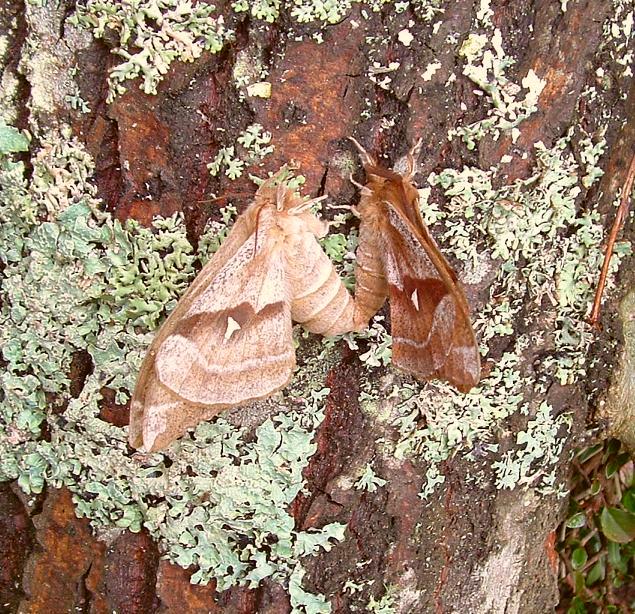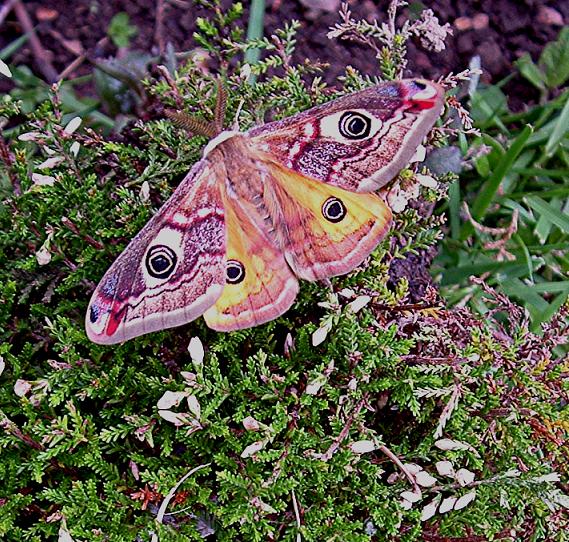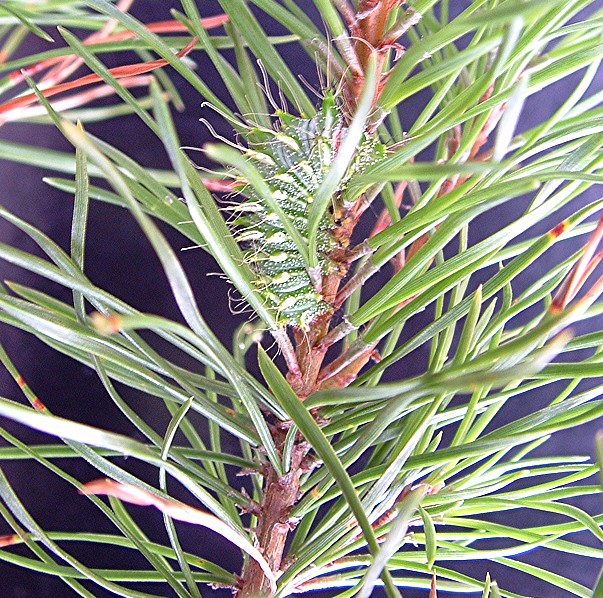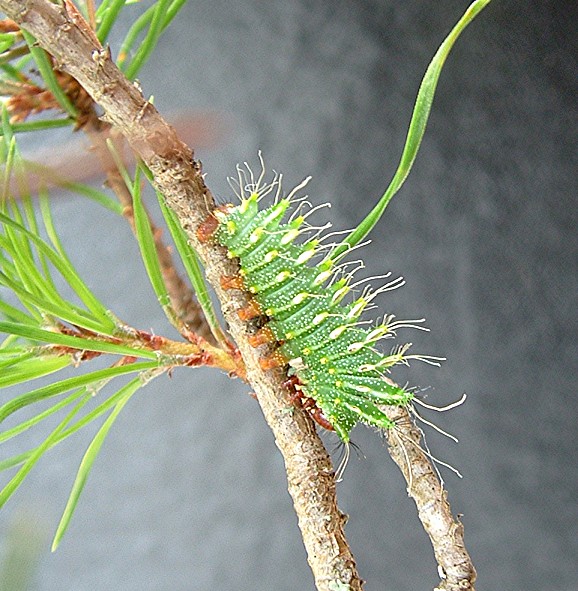|
PICTURE GALLERY 2008 a glimpse of photographs Please enjoy! Göran Waldeck |
|
|
|
|
April 21, two females of Actias selene emerged, here is one of them with exceptional long tails. |
|
|
|
Actias selene ningboana is a subspecies found in southern China. Here is a female which emerged June 12. |
|
|
|
First emerging of the year, a female Endromis versicolora, Mars 30, 2008. She will not fly away until she is mated |
|
|
|
This versicolora pair mated when the temp was minus 4 Centigrades, April 11 |
|
|
|
Larvae from the mating above. May 31. The young larvae are very social and stay together. To avoid discovery they rise their heads and do not move. Foodplant: Betula. |
Aglia tau Linnaeus 1758
|
|
|
A wild male attracted by the pheromones of a bred female. Photo © Jonas Waldeck. |
 |
|
Aglia tau pair mating, May 3. Aglia tau is mostly active daytime. |
Epicnaptera / Phyllodesma ilicifolia Linnaeus 1758
|
May 14 |
|
A female adult has just crawled out of its yellowish cocoon trying to find a place to fold out her wings. The larva was found last year on Vaccinium myrtillus and pupated well. |
|
|
|
After 20 minutes the procedure is completed |
|
|
|
May 15. The female was put into a pairing trap over the night and placed on the spot where the larva once was found. In the morning a male was in the trap and the mating was already finished. |
|
|
|
June 11. An ilicifolia egg has hatched on a Vaccinium myrtillus leaf. Here shown with larva 3 mms of lengh. |
Araschnia levana Linnaeus 1758
|
|
|
May 15. A pupa from previous year emerged. The adult female is drying its wings on its foodplant Urtica dioica. |
|
|
|
The female has more rounded forewings and heavier abdomen than the male. May 15. |
Eudia pavonia Linnaeus 1758
 |
|
May 15. Also hibernation from previous year, a male today emerged from its cocoon. |
Cosmotriche lunigera Esper 1784
|
|
|
Cosmotriche lunigera male just emerged from its pupa & soft cocoon May 28. Lunigera larvae are feeding from pine trees. |
Mimas tiliae Linnaeus 1758
|
|
|
|
Mimas tiliae female has just left its pupal case and started to form the wings |
Now the wings are ready but still very soft |
|
|
|
Mimas tiliae female in normal position, tiliae is one of our most colourful hawk moths. This specimen is from larva pupated in 2007. Emerged May 28. |
|
|
|
The tiliae male is smaller, the reddish parts on the forewings are substituted with a whitish colour, the antennae are wider. June 2. |
|
|
|
Another tiliae male will show the variety in colour. This specimen has even more white forewings. June 8. |
|
|
|
A tilia female with crippled wings (above) was set out in a mating trap in the evening June 7; in the morning June 8 there was a wild male mating her. |
|
|
|
June 9. The tilia female has laid on a tilia leaf and twig a lot of oval eggs during the night. Size1 mm. |
Brahmaea hearseyi White 1862
|
|
|
Brahmaea hearseyi larva, two weeks old, placing its body in a sphinx position. May 30. Breeding area of this species is South East Asia. In captivity the larva accepts well ligustrum as foodplant. |
|
|
|
The larva is growing very fast, here trying to scare away a potential enemy, June 5. |
|
|
|
The last instar larva has left its skin and long horns behind, long feet attach the larva to the ligustrum twig. June 5. |
|
|
|
When the huge orange, turquoise, black and white larva is full-grown, it is moving to the ground searching for place to pupate. June 10. |
Cerura erminea Esper 1783
|
|
|
|
Wooly Cerura erminea female drying its wings after emerging from its pupa inside the cocoon made of wooden material. June 6. |
The wings in normal position. June 7. In the cage there was also an erminea male. I assume there was a mating during last night as some peculiar, orange and green flat eggs already have been laid. |
Cerura vinula Linnaeus 1758
|
|
|
Cerura vinula pair mating on a tree trunc. The male with glassine wings to the right. June 10. |
Hybocampa milhauseri Fabricius 1775
|
|
|
Hybocampa milhauseri male just emerged. He has cut a hole in his, on a twig attached, papered cocoon. June 13. |
Creatonotos gangis Linnaeus 1763
|
|
|
C gangis belonging to the Arctiidae group, breeds in Southern Asia and is pest on cultivated plants as sugar cane and rice. June 15. |
Pericallia matronula Linnaeus 1758
|
|
|
P matronula is a giant and the biggest of all European Arctiidae. This female emerged June 19. The larvae from last year hibernated in the snow. |
Euproctis similis Fuessly 1775
|
|
|
Euproctis similis male has a dark spot on forewings and much hairy legs. July 20. |
Euproctis chrysorrhoea Linnaeus 1758
|
|
|
Euproctis crysorrhoea is an extremely rarely seen species in our area. This larva is resting on an apple leaf. July 1. |
Lymantria dispar Linnaeus 1758
|
|
|
|
Lymantria dismar female drying its wings after emerging from the pupa. July 21. |
After a while the wings are placed in the normal resting position. July 21. |
|
|
|
The L dispar male is much smaller, coloured dark grey with blackish, wavy lines. July 23. |
Actias dubernardi Oberthür 1897
 |
 |
Dubernardi larvae with silver spots, here feeding on Pinus silvestris L. Aug 27.
Epiphora bauhini
|
|
|
Epiphora bauhini female finally emerged Sept 17. This nice silk moth breeds in Senegal |
Copyright © 2008 ![]() Göran
Waldeck All rights reserved
Göran
Waldeck All rights reserved
Last updated Sept 17, 2008